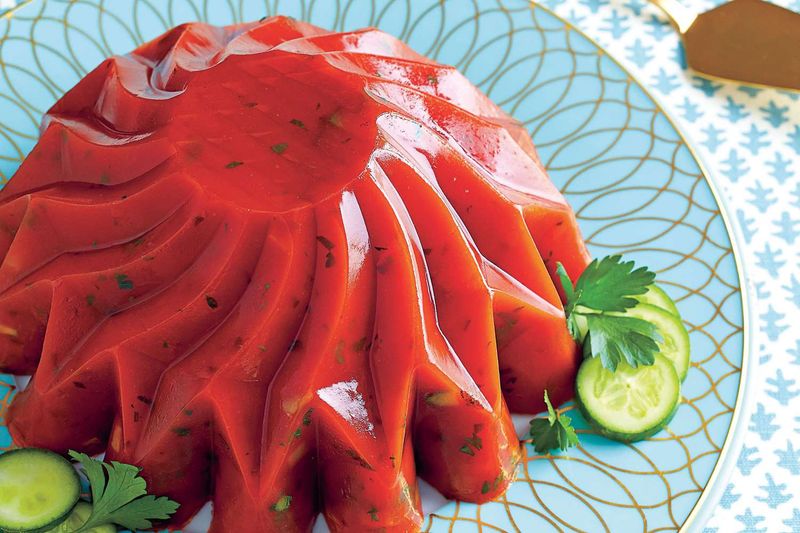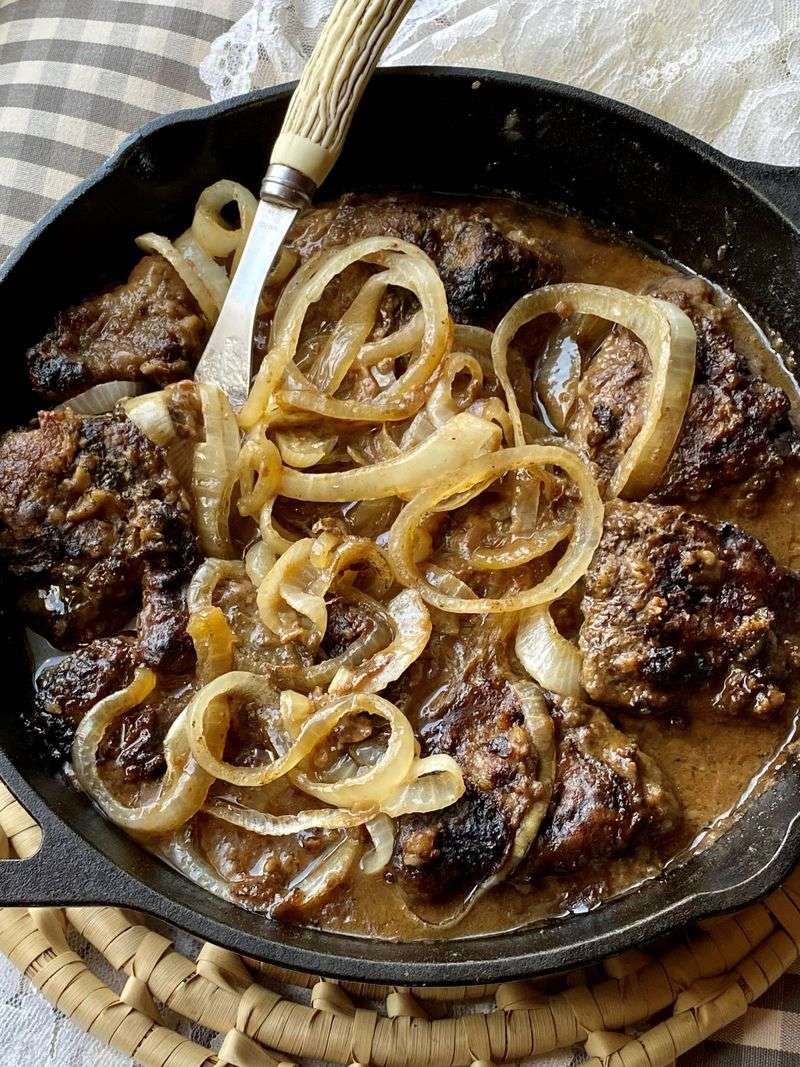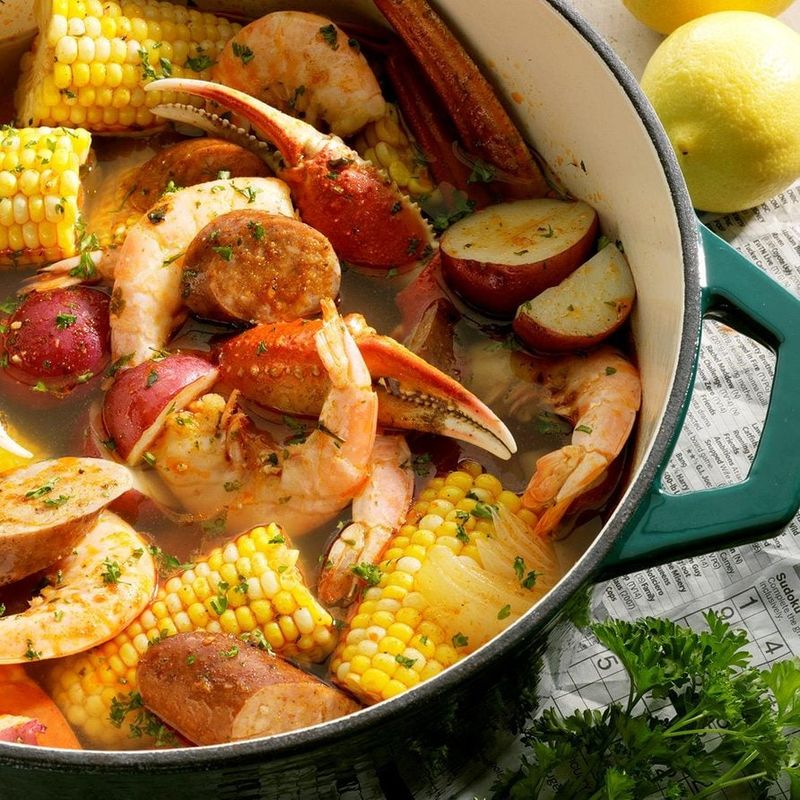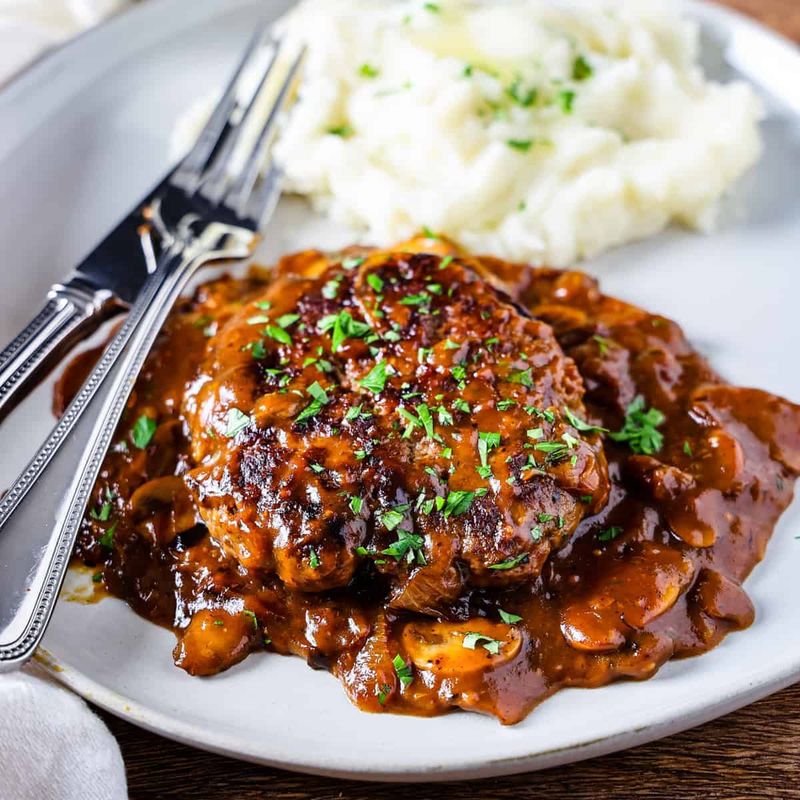In the ever-changing culinary landscape of the United States, some foods have managed to cling to existence despite declining popularity. These classic dishes, once cherished staples of American cuisine, are now considered rare finds, more cherished for their nostalgia than their taste. Whether due to changing taste preferences, dietary trends, or the rise of more convenient alternatives, these foods are barely hanging on. As we explore these 20 classic U.S. foods, we take a trip down memory lane, remembering the flavors that once defined generations and the stories that accompany them.
Tomato Aspic

Tomato Aspic, a savory gelatin dish, evokes mixed reactions. Made with tomato juice, it was often served as a salad course in mid-century America. Its firm texture and tangy taste were both novel and divisive.
As fresh salads gained popularity, Tomato Aspic fell by the wayside, but it remains a quirky culinary relic.
Interesting fact: Aspics were once a sign of culinary prowess, showcasing the ability to mold and present foods creatively, making them a centerpiece in historical feasts.
Ambrosia Salad

A staple of Southern gatherings, Ambrosia Salad mixes citrus, marshmallows, and coconut in a sweet, creamy concoction. Its origins trace back to the late 19th century, celebrated as a luxurious treat. Today, it evokes memories of family picnics and church potlucks.
While modern tastes have shifted, its nostalgic charm remains. Many recall their grandmothers crafting this salad with a loving touch, stirring together colorful fruits.
The first bite often transports one back to simpler times, where flavors mingled at community feasts. Such sentimental ties keep Ambrosia from disappearing entirely.
Beef Wellington

Beef Wellington, an embodiment of culinary opulence, marries tender beef fillet with a rich mushroom duxelles, wrapped in flaky pastry. Named after the Duke of Wellington, its origins are debated, but its status as a dinner party showstopper is uncontested.
This dish’s complexity and cost make it a rare find today, yet its allure endures. Each slice reveals layers of flavor, a testament to skilled preparation.
For those who seek a taste of elegance, Beef Wellington remains an iconic choice, preserving a touch of grandeur amidst modern simplicity.
Succotash

Once a staple in American homes, Succotash combines corn and lima beans, seasoned with salt and pepper. Its simplicity and nutritional value made it a household favorite, particularly during the Great Depression.
As culinary trends evolve, succotash has become less common, yet its legacy endures in regional fairs and family gatherings. Each spoonful offers a taste of history, connecting generations through a humble blend of ingredients.
Though overshadowed by more contemporary creations, succotash’s enduring appeal lies in its wholesome, comforting nature.
Jell-O Salad

Jell-O Salad, a quintessential mid-century creation, combines vibrant gelatin with fruit and sometimes vegetables or whipped cream. It was a fixture at potlucks and holiday tables, celebrated for its versatility and visual appeal.
Though less frequent today, its playful nature still captivates. The jiggle of the gelatin and bursts of fruit offers a light-hearted dining experience.
For many, Jell-O Salad is a reminder of festive gatherings, where creativity had no bounds. It stands as a testament to the era’s culinary innovation.
Corned Beef Hash

Corned Beef Hash, a dish born from frugality, transforms leftovers into a beloved breakfast favorite. Combining corned beef, potatoes, and onions, it offers a hearty, satisfying start to the day.
In the past, this dish was a practical solution to food waste, yet its savory appeal has transcended time. Diners still serve it, honoring tradition with every crispy, flavorful bite.
The sizzling sounds and savory aroma of Corned Beef Hash cooking evoke memories of leisurely Sunday mornings.
Liver and Onions

Liver and Onions, a dish of humble origins, pairs sautéed liver with caramelized onions. Once a regular feature on dinner tables, it provided an affordable source of nutrition.
Today, it’s viewed with mixed reactions, but for those who grew up with it, the dish holds fond memories. The rich aroma of onions sizzling in a pan evokes a sense of nostalgia.
While not for every palate, Liver and Onions remains a cherished comfort food for many, offering a savory reminder of simpler culinary times.
Hot Brown Sandwich

Originating from the Brown Hotel in Louisville, Kentucky, the Hot Brown Sandwich is an indulgent open-faced delight. It layers turkey, bacon, and Mornay sauce atop toast, broiled to perfection.
Created in the 1920s as a late-night snack for dance guests, its rich flavors made it a lasting favorite. While not ubiquitous today, its loyal following appreciates the unique combination of textures.
For those seeking a taste of Southern hospitality, the Hot Brown remains a must-try dish, embodying warmth and tradition.
Frogmore Stew

Despite its name, Frogmore Stew contains no frogs. This Lowcountry boil, also called Beaufort Stew, combines shrimp, sausage, corn, and potatoes in a flavorful broth.
Often served at outdoor gatherings, it’s a communal dish that brings people together. Though not as common today, its preparation remains a cherished tradition in Southern communities.
The mix of seafood and spices creates an enticing aroma, inviting everyone to gather around. Frogmore Stew is a celebration of Southern culture and camaraderie.
Charlotte Russe

Charlotte Russe, a dessert of elegance, features a creamy custard encased in ladyfingers. Its origins date back to 18th-century Europe, but it found a place in American homes, particularly during the holidays.
In an era of quick desserts, Charlotte Russe stands out for its artistry and rich flavors. Though rare, it remains a symbol of culinary refinement and festive celebration.
Each bite of this dessert is a journey to the past, where desserts were crafted with care and creative flair.
Scrapple

Scrapple, a dish rooted in thriftiness, combines pork scraps with cornmeal, creating a savory loaf. Popular in Pennsylvania Dutch country, it was a means to utilize every part of the hog.
Fried to a crisp, scrapple offers a unique texture and flavor, appealing to those who appreciate traditional fare. Though its audience has dwindled, its cultural significance endures.
Scrapple is more than just a meal; it’s a connection to simpler times and a testament to resourceful cooking.
Salisbury Steak

Salisbury steak, a nostalgic comfort food, was a staple in mid-20th century American kitchens. Its hearty beef patty, drenched in savory gravy, evokes memories of homestyle dinners.
Originating from Dr. James Salisbury’s quest for a healthful meat dish, it became popular during wartime when rationing was common.
Today, it’s rare to find Salisbury steak outside of diners or frozen meal aisles. Its decline reflects changing tastes and culinary trends. Despite this, its rich flavor profile continues to offer a taste of yesteryears.
Oxtail Soup

Oxtail soup, once a Sunday dinner highlight, is a dish rooted in frugality and flavor. The slow-cooked oxtail, combined with hearty vegetables, creates a broth that’s both robust and comforting.
Its origins trace back to immigrant communities using every part of the animal. Over time, it became a comforting staple in diverse kitchens.
However, its lengthy preparation process and the rise of modern convenience foods have pushed it to the sidelines. Yet, for some, it remains a cherished link to culinary heritage.
Egg Cream

The New York egg cream, an iconic soda fountain drink, is deceptively simple yet nostalgically sweet. Despite its name, it contains neither egg nor cream, just milk, seltzer, and chocolate syrup.
It originated in the 1920s, capturing the hearts of city dwellers with its fizzy, creamy allure. Soda fountains served it as a refreshing treat on hot days.
Today, its presence is limited to specialty shops and nostalgic eateries. As classic diners vanish, so does the egg cream’s prominence, leaving behind whispers of its effervescent charm.
Welsh Rarebit

Welsh rarebit, a savory cheese sauce on toast, recalls an era of simple yet satisfying fare. Often mistaken for ‘rabbit,’ it’s a dish of cheesy comfort.
Brought to America by Welsh immigrants, it became a popular supper dish in the early 1900s, especially in urban areas. Its creamy, tangy sauce is rich and indulgent.
Today, it’s mostly found in specialty restaurants and among culinary enthusiasts. Its decline mirrors the rise of fast dining options, though it still offers a warming taste of heritage.
Chicken à la King

Once a symbol of sophistication, Chicken à la King graced the tables of fine dining establishments. This creamy chicken dish, with mushrooms and pimientos, was a delight for many gourmets.
Its exact origins are debated, but it thrived in the early 20th century, offering a luxurious taste experience.
Its presence has dwindled in modern menus, overshadowed by contemporary cuisine. In certain circles, however, it’s still celebrated for its rich, velvety texture and its place in culinary history.
Green Goddess Dressing

Green Goddess dressing, a vibrant blend of herbs and creamy dressing, was the height of salad sophistication in the 1920s. Its vivid color and rich flavor made it a favorite.
Created in San Francisco, it was inspired by a play of the same name and became a staple in upscale restaurants.
Over time, simpler dressings gained popularity, leading to its decline. Yet, for those who seek a flavorful, herby dressing, it remains a cherished culinary gem, evoking the elegance of a bygone era.
Mulligan Stew

Mulligan stew, a dish of humble origins, symbolizes the resourcefulness of early American communities. This stew, often made with whatever was available, brings together a medley of meats and vegetables.
It gained popularity during the Great Depression, when using scraps was necessary. Its flavors are as diverse as the ingredients that go into it.
In today’s fast-paced world, this slow-cooked dish is rare. Those who enjoy it appreciate its hearty, warming essence, connecting them to a history of resilience and simplicity.
Chiffon Pie

Chiffon pie, a dessert with a cloud-like texture, was a culinary innovation of the 1920s. Its airy, mousse-like filling, often in flavors like lemon or chocolate, captivated sweet tooths.
Invented by a California insurance agent, it revolutionized pie-making with its lightness and elegance.
While modern dessert trends focus on richer, denser sweets, chiffon pie remains a delightful nod to an era of culinary experimentation. It’s a reminder of the days when innovation brought new textures to traditional baking.
Chicken and Dumplings

Chicken and dumplings, a hearty dish of Americana, evokes a sense of warmth and home. The combination of tender chicken and soft, pillowy dumplings creates a comforting meal.
This dish has roots in Southern kitchens, where it was a staple on many tables. It’s a testament to simpler times and home-cooked nourishment.
Though it’s not as common in restaurants today, those who make it cherish its nostalgic value. The soothing flavors remind many of family gatherings and cozy evenings.
Leave a comment